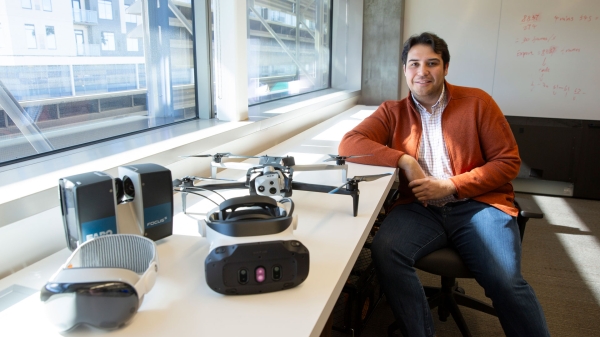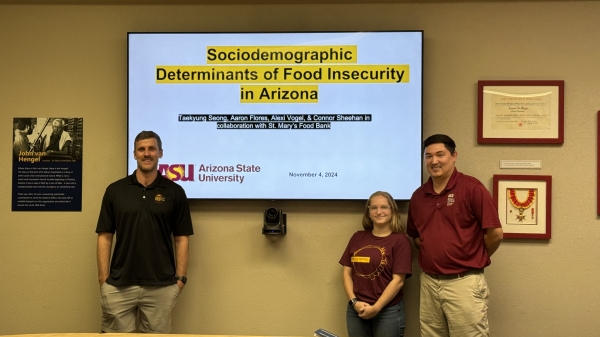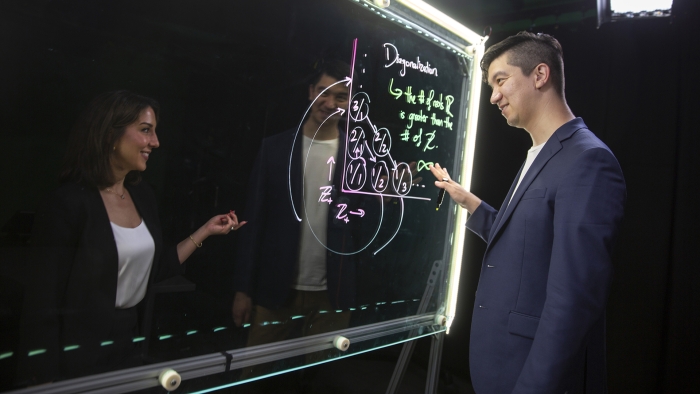Theoretical computer science, real-life student success

Joshua Daymude, an assistant professor of computer science and engineering in the School of Computing and Augmented Intelligence, part of the Ira A. Fulton Schools of Engineering at Arizona State University, reviews a presentation with Lindsey Lewandowski Robinson. The pair worked together to create a new hybrid learning model for a challenging theoretical computer science class. Lewandowski Robinson is a senior learning-experience designer in ASU’s FSE Learning and Teaching Hub. Their team partners with faculty members to design engaging learning experiences. Photo by Erika Gronek/ASU
A computer science class about the limits of technology has instead long tested the limits of students — and an Arizona State University team is working to make it more accessible and engaging.
When Joshua Daymude, now an assistant professor in the Ira A. Fulton Schools of Engineering, took his CSE 355: Introduction to Theoretical Computer Science as an undergraduate at ASU, he and fellow students often struggled with the fast pace of new abstract concepts and the infrequent feedback they got on assignments.
When he assumed a faculty role and was tasked with teaching CSE 355, Daymude observed that the class — required for most computer engineers — had an unusually high retake rate, a sign that many students struggled with the topic.
“The class argues that there are infinitely more things computers cannot do than what they can do,” he says. “And these things that they can’t do aren’t just mathematical curiosities but are actually important considerations in software design.”
In the class, students ponder questions like: Can different programming languages have fundamentally different capabilities? What makes one problem harder than another? They answer these questions by developing logical and mathematical proofs, and Daymude says that some learners can have trouble adjusting to the class format.
“All of a sudden, there’s no code,” says Daymude, who teaches in the School of Computing and Augmented Intelligence. “It feels much more like a pure math or even philosophy class than it does computer science. So it throws a lot of students for a loop.”
He began to wonder if new developments in technology, combined with a thoughtful, empathetic understanding of the student experience, could improve student outcomes.
“The material is challenging, but it was clear that something needed to be done differently with the class itself,” Daymude says. “We needed to build new touch points for students to engage with the material in a way that helps them achieve real mastery.”
Daymude turned to Lindsey Lewandowski Robinson and her teammates. Robinson is a senior learning-experience designer in ASU's FSE Learning and Teaching Hub. She and her team use their expertise to help faculty members reinvigorate their curricula.
Together, Daymude and Lewandowski Robinson created a totally new teaching model for CSE 355. They developed a fully remote class for the ASU Online program and a hybrid version for on-campus students. In the hybrid class, students watch the same video lectures as their ASU Online counterparts, then complete in-person learning activities in a highly interactive space.
Lewandowski Robinson explains that her team worked with Daymude to bring the best of both worlds to all students.
“We aimed for the in-person and online experiences to be aligned but with variations that keep the audience top of mind,” she says. “Our goal is to give in-person students a compelling reason to attend class while ensuring online students have the resources to feel fully supported.”
They divided the curriculum into smaller, weekly modules that are each kicked off with short but engaging video lectures from Daymude, recorded in the Learning and Teaching Hub’s media studio. The lectures have questions and discussion topics included to make them as interactive as possible. After watching the videos, online students use Slack and other learning technologies to collaborate, while on-campus attendees engage in class.
They also added assignments designed to help students develop a more personal connection to the material. At key checkpoints throughout the semester, students use Zoom to create a video diary telling their “story so far,” helping them to explain, in plain language, what they are learning in class and why it matters.
“One of the things I’m most proud of that's new in this course is we put a big emphasis on storytelling,” Daymude says. “The videos help students reframe why they are learning this sometimes-abstract material and understand that what we are really teaching is the difference between what’s possible and impossible.”
From pilot program to proven success
In spring of 2024, Daymude and Lewandowski Robinson ran a small pilot to test the new format with a group of 14 students. Following highly successful results, they launched the revamped class in earnest this fall, with 60 students enrolled in an ASU Online section and an additional 140 students enrolled in a hybrid section.
Ross Maciejewski, director of the School of Computing and Augmented Intelligence, commends the collaboration and says it exemplifies the hard work being done by the school to ensure student success.
“A mastery of theoretical computer science pays off richly over an engineer’s career. The fundamentals really are forever,” he says. “Ensuring that our students understand this material is essential, and Josh’s work will keep our students competitive in a field where hardware and software continues to change at a fast pace.”
More Science and technology

Teaching construction realities with virtual environments
Visiting a construction site is a valuable learning opportunity for students who want to one day work in the industry. Experiencing the sights, sounds and other sensory elements of an active…
ASU, Mexico partner to build next generation of chipmakers, drive semiconductor innovation
Thousands of college students in Mexico will soon have the opportunity to enroll in Arizona State University’s new, free online course to learn the fundamentals of microelectronics and…

ASU, St. Mary’s Food Bank partner to tackle food insecurity in Arizona
Arizona State University and St. Mary’s Food Bank (SMFB) have joined forces to create an interactive data dashboard that tracks and maps food insecurity rates across Arizona. This innovative tool…
